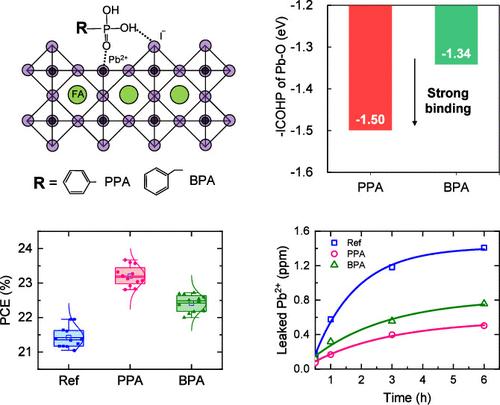膦酸分子内几何结构对钙钛矿太阳能电池表面钝化和铅固定化的影响
IF 18.2
1区 材料科学
Q1 CHEMISTRY, PHYSICAL
引用次数: 0
摘要
后处理卤化铅钙钛矿膜有效钝化表面缺陷和固定铅。我们报道了膦酸的分子内几何结构如何影响使用苯基膦酸(PPA)和苯基膦酸(BPA)的钙钛矿太阳能电池(PSCs)的光伏性能和铅潴留。虽然PPA中的苯基与适度给电子的苯基相比具有弱的吸电子性质,但PPA的磷系锚定基与欠配位的Pb2+通过配位键以及与碘离子通过氢键的相互作用更强。这些效应源于PPA的高偶极矩,这是由于苯环和膦基团之间的共线排列造成的。因此,ppa处理的钙钛矿薄膜表现出比bpa处理的薄膜更长的载流子寿命和更低的陷阱密度。PPA处理后的功率转换效率由22.75%提高到24.61%,由于PPA与钙钛矿的相互作用增强,Pb2+泄漏明显减少。本文章由计算机程序翻译,如有差异,请以英文原文为准。

Effect of Intramolecular Geometry in Phosphonic Acid on Surface Passivation and Lead Immobilization in Perovskite Solar Cells
Post-treatment with lead halide perovskite films effectively passivates surface defects and immobilizes lead. We report how the intramolecular geometry of phosphonic acids influences photovoltaic performance and lead retention in perovskite solar cells (PSCs) using phenyl phosphonic acid (PPA) and benzyl phosphonic acid (BPA). Although the phenyl group in PPA possesses a weak electron-withdrawing nature compared to the moderately electron-donating benzyl group, PPA exhibits stronger interactions between its phosphonic anchoring group and undercoordinated Pb2+ through coordination bonding, as well as with iodide via hydrogen bonding. These effects originate from the higher dipole moment of PPA, resulting from the collinear alignment between the phenyl ring and phosphonic group. Consequently, PPA-treated perovskite films show longer carrier lifetimes and lower trap densities than the BPA-treated ones. The power conversion efficiency increases from 22.75% to 24.61% after PPA treatment, and Pb2+ leakage is markedly reduced owing to stronger PPA-perovskite interactions.
求助全文
通过发布文献求助,成功后即可免费获取论文全文。
去求助
来源期刊

ACS Energy Letters
Energy-Renewable Energy, Sustainability and the Environment
CiteScore
31.20
自引率
5.00%
发文量
469
审稿时长
1 months
期刊介绍:
ACS Energy Letters is a monthly journal that publishes papers reporting new scientific advances in energy research. The journal focuses on topics that are of interest to scientists working in the fundamental and applied sciences. Rapid publication is a central criterion for acceptance, and the journal is known for its quick publication times, with an average of 4-6 weeks from submission to web publication in As Soon As Publishable format.
ACS Energy Letters is ranked as the number one journal in the Web of Science Electrochemistry category. It also ranks within the top 10 journals for Physical Chemistry, Energy & Fuels, and Nanoscience & Nanotechnology.
The journal offers several types of articles, including Letters, Energy Express, Perspectives, Reviews, Editorials, Viewpoints and Energy Focus. Additionally, authors have the option to submit videos that summarize or support the information presented in a Perspective or Review article, which can be highlighted on the journal's website. ACS Energy Letters is abstracted and indexed in Chemical Abstracts Service/SciFinder, EBSCO-summon, PubMed, Web of Science, Scopus and Portico.
 求助内容:
求助内容: 应助结果提醒方式:
应助结果提醒方式:


